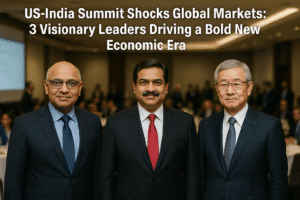US-India Summit Shocks Global Markets: 3 Visionary Leaders Driving a Bold New Economic Era
The US-India Strategic Partnership Forum (USISPF) Leadership Summit marks a pivotal moment, honoring three transformative business leaders – IBM’s Arvind Krishna, Aditya Birla Group’s Kumar Mangalam Birla, and Hitachi’s Toshiaki Higashihara – for their concrete roles in strengthening the US-India-Japan economic corridor, a core pillar of the Quad alliance. Krishna embodies India’s critical role in global tech innovation, Birla represents massive Indian investment ($15+ billion) creating US jobs, and Higashihara highlights Japan’s vital engineering contribution to trilateral infrastructure and digital projects.
The presence of Second Lady Usha Vance powerfully symbolizes deep people-to-people ties, while Commerce Secretary Howard Lutnick’s keynote focuses on actionable steps towards the ambitious $500 billion US-India trade goal. This summit underscores a strategic shift: leveraging the combined $35 trillion potential of the US, India, and Japan to build resilient supply chains, drive technological progress, and uphold a stable Indo-Pacific, moving beyond rhetoric to recognize the executives actively cementing this crucial alliance.

US-India Summit Shocks Global Markets: 3 Visionary Leaders Driving a Bold New Economic Era
The upcoming US-India Strategic Partnership Forum (USISPF) Leadership Summit in Washington D.C. is far more than a ceremonial gathering. It’s a strategic inflection point, recognizing the visionary business leaders actively forging the economic backbone of the Quad alliance (US, India, Japan, Australia) and signaling a profound shift in global partnership dynamics.
Honoring the Triad Driving Trilateral Synergy:
For the first time, USISPF bestows its prestigious Global Leadership Awards not just on individuals, but on a powerful trilateral economic engine:
- Arvind Krishna (IBM Chairman): Beyond IBM’s global tech dominance, Krishna’s recognition underscores India’s critical role as an innovation hub. IBM’s massive R&D footprint in India, driving breakthroughs in AI, quantum computing, and cloud solutions, exemplifies how talent and technological ambition in India are integral to global progress, not just bilateral ties. This is about India as a co-creator in the digital future.
- Kumar Mangalam Birla (Aditya Birla Group Chairman): Birla’s award highlights a transformative trend: Indian companies becoming major investors in the US economy. The Aditya Birla Group’s staggering $15+ billion in US greenfield investments – spanning manufacturing, renewable energy, and chemicals – represents a significant reversal of traditional capital flows. It signals India’s corporate capability and commitment to building tangible, job-creating assets within the US, strengthening economic interdependence.
- Toshiaki Higashihara (Hitachi Executive Chairman): Hitachi’s deep engagement in India and the US, particularly in critical infrastructure, mobility, and digital solutions, showcases Japan’s unique value. Higashihara’s leadership emphasizes the Quad’s practical collaboration: combining Japan’s advanced engineering prowess, India’s vast market and talent pool, and America’s innovation ecosystem to build resilient, modern infrastructure crucial for future growth and security.
More Than Speeches: Symbolism and Substance:
- Usha Vance: The participation of the Second Lady, the first Indian-American in this role, is profoundly symbolic. It visually represents the powerful “people-to-people” ties that form the bedrock of the US-India relationship. Her presence transcends politics, embodying the deep familial, cultural, and professional connections binding the two societies.
- Howard Lutnick (Commerce Secretary): His keynote address carries significant weight. Articulating a concrete path towards the ambitious $500 billion bilateral trade target set by President Trump and PM Modi will be closely watched. His insights are expected to focus on actionable strategies to overcome barriers and unlock new sectors for collaboration, moving beyond rhetoric to practical frameworks.
The Strategic Imperative: Why This Trilateral Focus Matters:
USISPF President Mukesh Aghi aptly frames the summit’s core thesis: the US, India, and Japan represent over $35 trillion in economic power. Their collaboration isn’t just beneficial; it’s strategically essential.
- Countering Vulnerability: This trilateral push directly addresses the global imperative for diversified, resilient supply chains, reducing over-reliance on any single geography.
- Leveraging Complementary Strengths: Japan’s manufacturing excellence, India’s demographic dynamism and tech talent, and America’s innovation engine and capital markets create a uniquely powerful combination.
- Upholding a Rules-Based Order: The economic partnership is inextricably linked to a shared vision for a stable, secure, and rules-based Indo-Pacific region. Robust economic ties reinforce strategic alignment.
- The Quad’s Economic Pillar: While security cooperation often dominates Quad discussions, this summit powerfully spotlights the indispensable economic dimension. Honoring these business leaders validates the private sector’s crucial role in translating strategic intent into tangible progress.
The Path Forward:
The USISPF summit serves as a high-level catalyst. The real work lies in translating this recognition and dialogue into:
- Policy Action: Streamlining regulations, enhancing investment protections, and resolving trade disputes.
- Sectoral Deep Dives: Accelerating collaboration in critical areas like semiconductors, clean energy tech, advanced telecommunications, and defense manufacturing.
- SME Integration: Creating pathways for smaller businesses within the three nations to participate in the opportunities generated by large-scale partnerships.
In Essence:
This summit moves beyond platitudes. By honoring Krishna, Birla, and Higashihara, the USISPF shines a spotlight on the tangible, corporate-driven economic integration forming the foundation of the US-India-Japan partnership – a core element of the Quad’s vision. The presence of Vance and Lutnick reinforces the political commitment and human connections underpinning it. The message is clear: the future of global economic resilience and technological leadership is being actively built through this powerful trilateral collaboration, driven by visionary leaders whose contributions are now being formally recognized as pivotal to a new strategic era. The world will be watching not just the speeches, but the concrete initiatives that emerge from this powerful convergence.
You must be logged in to post a comment.